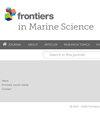水产网箱式海上浮式风力机水动力特性数值研究
IF 3
2区 生物学
Q1 MARINE & FRESHWATER BIOLOGY
引用次数: 0
摘要
全球对可再生能源的需求日益增长,使得海上风能的开发具有极其重要的意义。在海洋深度超过50米的地区,传统的永久基础在经济上是不可用的,因此漂浮式海上风力涡轮机(FOWTs)成为一个更好的选择。同时,近海地区海洋资源的开发已不能满足日益增长的市场需求,迫切需要将水产养殖渔业扩大到更深的水域。本研究开发了一个完全集成的网箱平台、网系统和系泊系统模型,与NREL 5MW风力发电机兼容。采用基于势流理论和Morrison方程的数值模拟方法,研究了不同海况下耦合系统的运动响应特性。研究结果表明,网络作为阻尼元件,显著降低了系统的运动响应,提高了系统的稳定性。在规则和不规则波浪环境下,特别是在极端海况下,系统的动力响应受浪高和周期的影响。此外,电网的存在对风力涡轮机的输出功率影响最小,同时有助于减轻功率波动。对受风、浪和电流影响的复杂环境的研究表明,电流速度的上升显著改变了系统的浪涌运动趋势,尽管它对功率输出的影响很小。本研究为深海风-渔业综合系统的设计与优化建立了理论框架,为海洋资源的最大化利用和风能的商业部署提供了见解。本文章由计算机程序翻译,如有差异,请以英文原文为准。
Numerical study on hydrodynamic characteristics of a submersible floating offshore wind turbine integrated with an aquaculture cage
The increasing global need for renewable energy has rendered the development of offshore wind energy extremely significant. In areas where ocean depths exceed 50 meters, conventional permanent foundations become economically unfeasible, becoming floating offshore wind turbines (FOWTs) a superior alternative. Simultaneously, the development of marine resources in offshore areas has failed to meet increasing market demand, necessitating the urgent expansion of aquaculture fisheries into deeper waters. This research developed a fully integrated model of a cage platform, net system, and mooring system, compatible with the NREL 5MW wind turbine. Numerical simulation methods, based on potential flow theory and Morrison’s equation, are utilized to examine the motion response characteristics of the coupled system under various sea conditions. The study results demonstrate that the net, acting as a damping element, significantly decreased the system’s motion response and enhanced its stability. The system’s dynamic response is influenced by wave height and period in both regular and irregular wave circumstances, particularly under extreme sea conditions. Furthermore, the net’s presence minimally affects the wind turbine’s power output while contributing to the mitigation of power fluctuations. The examination of complex environmental circumstances influenced by wind, waves, and currents reveals that a rise in current velocity markedly changes the system’s surge motion trend, although it has little impact on power output. The work establishes a theoretical framework for the design and optimization of deep-sea wind-fishery integrated systems, providing insights into the maximization of marine resource utilization and the commercial deployment of wind energy.
求助全文
通过发布文献求助,成功后即可免费获取论文全文。
去求助
来源期刊

Frontiers in Marine Science
Agricultural and Biological Sciences-Aquatic Science
CiteScore
5.10
自引率
16.20%
发文量
2443
审稿时长
14 weeks
期刊介绍:
Frontiers in Marine Science publishes rigorously peer-reviewed research that advances our understanding of all aspects of the environment, biology, ecosystem functioning and human interactions with the oceans. Field Chief Editor Carlos M. Duarte at King Abdullah University of Science and Technology Thuwal is supported by an outstanding Editorial Board of international researchers. This multidisciplinary open-access journal is at the forefront of disseminating and communicating scientific knowledge and impactful discoveries to researchers, academics, policy makers and the public worldwide.
With the human population predicted to reach 9 billion people by 2050, it is clear that traditional land resources will not suffice to meet the demand for food or energy, required to support high-quality livelihoods. As a result, the oceans are emerging as a source of untapped assets, with new innovative industries, such as aquaculture, marine biotechnology, marine energy and deep-sea mining growing rapidly under a new era characterized by rapid growth of a blue, ocean-based economy. The sustainability of the blue economy is closely dependent on our knowledge about how to mitigate the impacts of the multiple pressures on the ocean ecosystem associated with the increased scale and diversification of industry operations in the ocean and global human pressures on the environment. Therefore, Frontiers in Marine Science particularly welcomes the communication of research outcomes addressing ocean-based solutions for the emerging challenges, including improved forecasting and observational capacities, understanding biodiversity and ecosystem problems, locally and globally, effective management strategies to maintain ocean health, and an improved capacity to sustainably derive resources from the oceans.
 求助内容:
求助内容: 应助结果提醒方式:
应助结果提醒方式:


